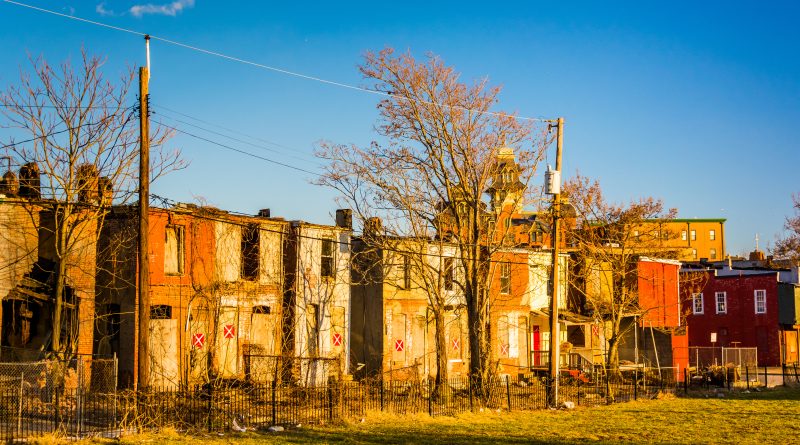Missing the Point – The problem with the BUILD vacant housing solution
In the featured image above, BUILD and other activists see blight. What they should envision is private sector-funded, next-generation light industry or urban agriculture employing hundreds and, collectively, thousands of Baltimore’s un- and under-employed citywide.
The BUILD organization – Baltimoreans United in Leadership Development – has come up with a plan to resolve the city’s massive inventory of vacant housing. Basically, the organization wants to create, to quote from the article in the Sun, “a quasi-governmental agency that would focus solely on vacant housing and oversee billions of dollars of public money” – $7.5 billion, to be precise, although it’s only an estimate. Mayor Scott’s endorsement of the plan is political and in no way validates the science or common sense on which it is based.
Like so many good and sincerely concerned Baltimore activists, the BUILD organization means well. Certainly, Baltimore has long suffered from a shortage of affordable housing and a vacant housing crisis, the resolution of which is an essential component of any plan to save the city. My problem is not with BUILD. Their efforts and those of others working to resolve the housing crisis are to be respected and greatly appreciated, but they’re missing the point.
For the sake of discussion and not to pick on it in particular, the BUILD program won’t accomplish its objectives.
“Why’s that?”
Well, for several reasons.
- For one thing, saving the city of Baltimore requires a simultaneous, multi-disciplinary approach that addresses all manner of problems, including housing of course, but which also involves large-scale economic, social, public safety, infrastructure, government, and political initiatives. Saving the city of Baltimore is not something that can be done piecemeal.
Collectively, even individually, these initiatives are more than can be accomplished by the city of Baltimore itself. The shortfall of the city’s capabilities necessary to achieve a meaningful, all-inclusive recovery isn’t just marginal, it’s huge. To save the city, both the state and federal governments need to be involved – with the state, not the city government, taking the lead role. The sooner people who count come to this conclusion, the greater the likelihood of success. (See “Missing the Point – Taking Over Baltimore,” published last week in the Baltimore Post-Examiner.)
- More importantly, the elements of a comprehensive program are not of equal standing. One in particular – the availability of jobs to resolve un- and under-employment in the city – is a root cause of many of the other problems, including the lack of affordable housing and the vacant housing crisis. (“Under-employed” people are those working for income, which is less than what they could earn were they properly educated and/or had the opportunity to be trained, on the job, to do higher paying jobs for which they could qualify.)
Baltimore’s housing crisis – the shortage of affordable housing and vast inventory of vacant properties – are not stand-alone problems in and of themselves. They are, instead, symptomatic of a chronically weak economy and would evaporate, eventually and organically, were the economy strong and thriving throughout the city.
The BUILD program, when you think about it, is an example of supply-side economics. Provide the housing and people – currently living in Baltimore – will rent or buy and maintain it. Really? With what money? Why does building or renovating a house that someone might want to inhabit have anything to do with their earning the income to afford it? It doesn’t. If only it were that easy. Nor are private sector housing developers going to invest their money in neighborhoods where the existing residents can’t afford the housing they build. Not going to happen.s
- Whatever the solution to the vacant housing problem, it can’t be about providing housing to “urban immigrants,” that is, to people who work in the city, but currently live elsewhere. Declining city population is a problem, but not where you start an effort to save the city. You’ve got to start with a solution that takes care of the people who already live in Baltimore. And if they can’t afford – on their own, without government assistance – to rent or buy and maintain quality housing, what’s the point of creating that housing in the first place?
Instead of viewing vacant housing as a blight upon the city, which it is, it’s more productive to view it as one of the city’s greatest assets that can be used, “leveraged” in a manner of speaking, to attract large volume employers. I’m talking about light industrial activity and other options, the workforce requirements of which match the city’s existing residents who need employment and jobs that pay higher wages. It’s not about the vacant houses. It’s about the properties on which they sit which, gifted by the city to the right employers with other incentives, can bring these companies to parts of Baltimore they would otherwise never consider.These jobs – smack dab in the heart of Baltimore neighborhoods where the need is greatest – jobs for the existing residents of these communities – will fund the demand for quality housing that more and more Baltimore residents can afford. And it won’t take a new “quasi-governmental” agency or billions of dollars to solve Baltimore’s housing problem. Not even close.
The trick to saving Baltimore – not just its vacant housing problem, but the whole kit and caboodle – is getting the state involved and, most importantly, to designing an overall, all-inclusive, comprehensive plan that leverages the heck out of the private sector. Not just the local private sector, but which involves investment from here and there throughout our entire national economy for which the billions that will be involved are relatively minuscule.
To do otherwise is the reason even the best-intended initiatives by the city government and community activists keep failing and the decline of a great American city continues. Decades of failure are urgently crying out for a new course.

Les Cohen is a long-term Marylander, having grown up in Annapolis. Professionally, he writes and edits materials for business and political clients from his base of operations in Columbia, Maryland. He has a Ph.D. in Urban and Regional Economics. Leave a comment or feel free to send him an email to [email protected].

